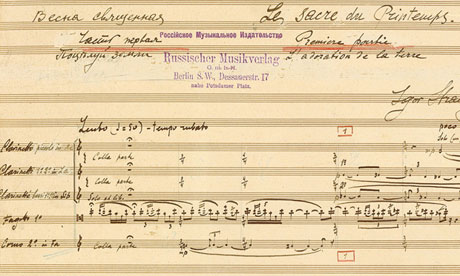As the new school year gets underway in earnest and routines start to establish themselves for the academic year once again, we decided to add a few items to our typical repertoire of activities to get us out of the house. Each month we will participate as a family in at least one cultural activity and one outdoor activity. Kim is going to organize our outdoor activities, and I am really excited to be taking charge of the cultural ones.
This month we are going to hear a performance by the Yale Philharmonia of the music from Igor Stravinsky's ballet The Rite of Spring, which scandalized audiences when it premiered in Paris in 1913. A century later, the work and its composer are much more well-known and the music from the ballet continues to receive top billing at concerts around the world. And though the history of 20th century classical music has perhaps softened some of the edginess of the Rite, it is still . . . well . . . a bit strange to tell the truth.
When I was younger, my Dad and I used to lay on the living room floor with our eyes closed surrounded by all-encompassing classical music playing from the family sound system. (Records anyone?) We listened carefully, sometimes over and over again, inventing stories about the music. It was in this way that I was introduced to many classical pieces which I continue to love to this day: Copland's Appalachian Spring, Strauss' Blue Danube, Tchaikovsky's 1812 Overture, Pachelbel's Canon, Bach's Toccata & Fugue in D-minor. (Dad, if you are reading this, these are some of my favorite memories.)
This love of music set the stage for my own "discoveries" as an adult of composers Steve Reich, John Adams, Edgar Meyer, Kevin Volans. And now with plans to hear a performance of The Rite of Spring next week, I fear I am only just now "discovering" Stravinsky and his Rite. (Regrets to Fantasia's dinosaur skit.)
Though there are times when simply immersing one's self in music is enough to elicit instant love-at-first-listen, I have found that, in general, I appreciate and enjoy classical music more when I understand a little more about the story surrounding the piece and its history. I find this true of 20th century classical music in general, and especially with more complex and storied pieces like Stravinsky's Rite of Spring.
I admit, I put the concert on our family calendar knowing simply that hearing a live performance of The Rite of Spring is a sort of rite of passage, if you'll excuse the pun. It was certainly not from a well-educated point of view that I listened to the entire piece from beginning to end for the first time only a few weeks ago to prepare myself. My reaction, perhaps like that of the Paris audience a century ago, was visceral. The haunting melodies that surge and emerge. The beat. The dissonance. I was intrigued by its strangeness.
Since then I have listened to the piece all the way through a number of times and to excerpts of the piece even more. I have also watched a performance of the original ballet choreography, which was lost for decades but revived in the 1980s after much research by the Joffrey Ballet (available on YouTube). In fact, watching the ballet instead of just hearing the music helped me appreciate the piece in a new way. Each time I hear the piece, I love it even more. It is beautiful in a terrifying way.
Because the work is so complex and unusual--and because I wanted my children to be able to truly enjoy the concert too--I worried that maintaining focus and interest at the concert hall next week would be too much to expect of them if they were not exposed to the piece ahead of time. Therefore, over the past few weeks I have been preparing a number of lessons and activities to introduce them to the piece and its history. We had our first lesson last night and it was a smashing success. Over the next few days, I intend to post my lesson outlines, as well as the products of each activity, so stay tuned!

No comments:
Post a Comment